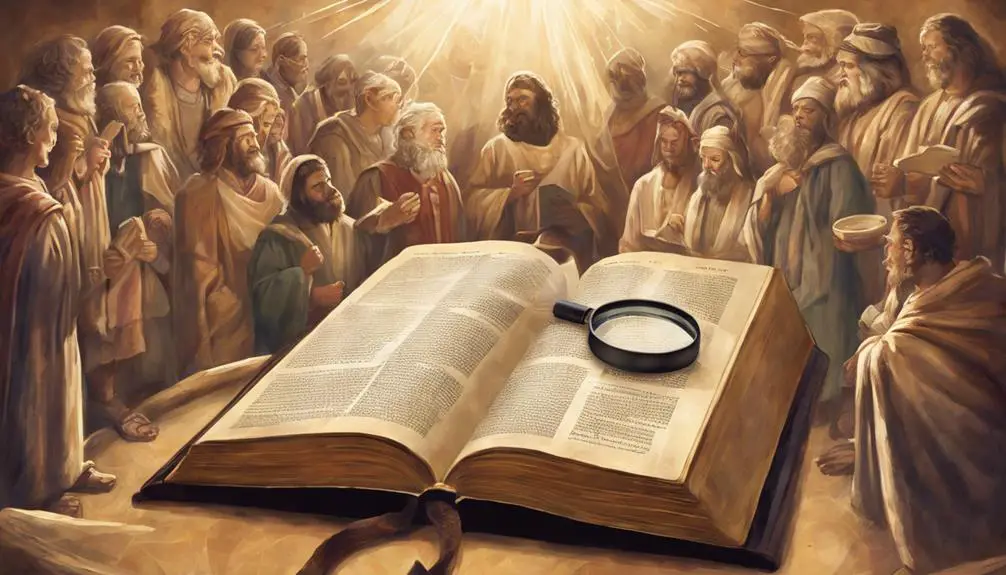Marvel at Psalm 119, the Bible's longest chapter, revealing unmatched depth in faith and devotion—discover why it captivates readers.

What's the Longest Chapter in the Bible
You might not be aware, but the longest chapter in the Bible isn't found in the epic narratives of Genesis or the profound prophecies of Isaiah, but nestled within the pages of Psalms.
Specifically, Psalm 119 stands out not just for its length, but for its unique structure and the depth of its thematic exploration. This chapter offers a fascinating glimpse into the complexities of faith, law, and devotion in a way that's unmatched elsewhere in the scriptures.
By taking a closer look, you'll uncover layers of meaning that could reshape your understanding of biblical literature and its impact on generations of readers and thinkers.
Key Takeaways
- Psalm 119 is the longest chapter in the Bible, comprising 176 verses.
- It follows an acrostic pattern, corresponding to the 22 letters of the Hebrew alphabet.
- The chapter emphasizes meditation on God's law and commandments through its unique structure.
- Psalm 119's length and intricate design signify a deep exploration of faith, law, and devotion.
Identifying the Longest Chapter

Upon examining the Holy Bible, you'll find that Psalm 119 stands out as the longest chapter, consisting of 176 verses. This distinction isn't merely numerical; it embodies a profound chapter length significance that merits a comparative analysis with other biblical chapters.
Unlike shorter psalms or narratives, Psalm 119's extensive verse count isn't incidental. It's structured around an acrostic pattern, divided into 22 stanzas, each corresponding to a letter of the Hebrew alphabet. Each section begins with its respective letter, an intricate design that underscores the depth of meditation on the law and commandments of God.
This comparative analysis reveals that the length isn't just about quantity but quality and structure, offering a unique lens through which to understand its composition. Other chapters, while significant, don't exhibit the same level of complex organization or thematic dedication.
Psalm 119's unparalleled length thus serves as a testament to its exhaustive exploration of faithfulness, law, and devotion. This chapter not only stands out for its size but for the meticulous craftsmanship and profound spirituality that its length allows it to convey, setting a distinct standard for biblical literature.
Unveiling Psalm 119
Exploring Psalm 119 further reveals its intricate structure and profound themes, emphasizing its significance within the tapestry of biblical texts. This Psalm stands out not only for its length but also for its unique use of acrostic patterns, deeply intertwined with the Hebrew alphabet. Each section of this Psalm begins with a successive letter of the Hebrew alphabet, illustrating a meticulous and artistic design that enriches its spiritual and literary value.
The structure of Psalm 119 reflects a deliberate attempt to encompass the entirety of human experience—ranging from moments of profound despair to peaks of ecstatic joy—through a lens of devout faith. This methodical approach underscores the Psalmist's endeavor to articulate a comprehensive meditation on the virtues of God's law and commandments.
Hebrew Letter |
Section |
Theme |
|---|---|---|
Aleph |
1-8 |
Purity and Blessedness |
Beth |
9-16 |
The Word and Youth |
Gimel |
17-24 |
Divine Generosity |
Daleth |
25-32 |
Humility and Revival |
This table exemplifies the initial segments of Psalm 119, illustrating how each is dedicated to a specific theme, intricately connected through its alphabetic acrostic. Such a structure invites a deeper reflection on the symbiotic relationship between the divine precepts and the human experience, guided by the wisdom of the Hebrew alphabet.
Analyzing Its Structure

Delving into the structure of Psalm 119 reveals a sophisticated, acrostic composition that meticulously aligns with the Hebrew alphabet, underscoring its profound spiritual depth and literary genius. This analysis offers a closer look at its unique structure and the literary techniques it employs:
- Acrostic Pattern: Each of the 22 sections corresponds to a letter of the Hebrew alphabet, with every line in a section beginning with that letter. This intricate design not only serves a mnemonic purpose but also emphasizes the completeness and universality of the Psalm's themes.
- Use of Parallelism: A common literary technique in Hebrew poetry, parallelism is employed extensively throughout Psalm 119. This involves the repetition of words or phrases to amplify a concept or to present a contrast or comparison.
- Inclusion of Personal Appeals: The Psalmist intersperses personal appeals and reflections within the structured framework, adding a deeply personal touch that resonates with readers across generations.
- Chapter Divisions: Unlike modern chapter divisions, the original text's divisions were carefully crafted to align with the acrostic nature, further highlighting the Psalmist's literary prowess.
Through these elements, Psalm 119's structure not only facilitates memorization but also enriches its literary and spiritual impact.
Exploring Thematic Depth
Having examined the intricate structure of Psalm 119, let's now turn our attention to its thematic depth, which reveals a rich tapestry of spiritual insights and ethical teachings. Delving into its verses, you'll uncover layers of meaning that are deeply embedded within its historical context and enhanced through sophisticated literary devices.
Psalm 119, as the longest chapter, isn't just a marvel of length but a profound exploration of the relationship between the divine and the devout. It intricately weaves themes of devotion, obedience, and the transformative power of divine laws. Historical context is pivotal here; understanding the era and circumstances in which it was written adds layers of significance to its admonitions and praises. It's not merely a collection of verses but a reflection of a community's spiritual journey, anchored in the trials and triumphs of its time.
Moreover, the Psalm's use of literary devices—such as acrostics, parallelism, and metaphor—enriches its thematic depth. These aren't just stylistic choices but tools that underscore the Psalm's messages, making its spiritual and ethical teachings resonate more profoundly. Through this careful analysis, you're invited into a deeper appreciation of its enduring wisdom.
Impact and Interpretations

The interpretation of Psalm 119 has profoundly impacted both individual spirituality and theological discourse, revealing its multifaceted significance across centuries. This chapter's rich tapestry of themes offers insights that bridge historical context with modern relevance. Here's how:
- Historical Context: Initially, Psalm 119 served as a guide for meditation and prayer, deeply rooted in the Jewish tradition. Its acrostic structure and references to the Torah underscore its significance within its original context, offering a window into the spiritual and cultural practices of ancient times.
- Literary Significance: Scholars have long debated the literary devices and structure of Psalm 119, noting its unique position as the longest chapter. This has led to a deeper understanding of biblical poetry and its techniques.
- Spiritual Formation: For individuals, Psalm 119 has been a source of inspiration and guidance. Its emphasis on the value of God's law for personal conduct and spirituality continues to resonate with believers, encouraging a life aligned with divine principles.
- Modern Relevance: In contemporary discussions, Psalm 119 challenges readers to consider the enduring importance of scripture in guiding moral and ethical decisions, bridging ancient wisdom with today's complex world.
Frequently Asked Questions
How Does the Length of Psalm 119 Compare to Chapters in Religious Texts Outside of the Bible?
When you're comparing chapter lengths across different religious texts, Psalm 119's impressive length stands out. It's fascinating to analyze how its size holds up against chapters from other sacred writings.
In these chapter comparisons, you'll find that text lengths vary widely, reflecting diverse literary traditions and theological emphases. Your detailed, scholarly approach reveals that, while Psalm 119 is exceptionally long within the Bible, its length isn't unparalleled in the broader religious literary landscape.
What Are Some Unique Ways Individuals or Groups Have Memorized or Celebrated Psalm 119 Throughout History?
Throughout history, individuals and groups have engaged with Psalm 119 in fascinating ways. Prayer marathons, lasting days, have been dedicated to its recitation, reflecting on its depth and seeking spiritual enlightenment.
Calligraphy exhibitions have showcased this chapter, turning its verses into visual art that captures its beauty and complexity. These practices not only honor the text's significance but also highlight the creative and diverse approaches to engaging with scripture.
Are There Any Notable Pieces of Music or Art Inspired Specifically by Psalm 119, Beyond the General Influence on Culture?
You might find it fascinating that Psalm 119 has inspired numerous musical adaptations and artistic representations. These works delve deep into the text's themes, translating its spiritual nuances into auditory and visual forms.
Composers and artists have meticulously drawn from its verses, creating pieces that not only celebrate but also critically explore the Psalm's intricate layers. This artistic engagement offers a profound, multi-sensory experience of the scripture, enriching its interpretation and appreciation.
How Has the Interpretation of Psalm 119 Evolved With Modern Biblical Scholarship and Translations?
You might think Psalm 119's length makes it less accessible, but modern biblical scholarship has actually uncovered deeper layers, enhancing its relevance.
Scholars have delved into its acrostic significance and searched for hidden messages, offering fresh perspectives. This analytical approach has revealed how its structure and content interact more complexly than previously understood.
Such insights show how translations evolve, ensuring Psalm 119's teachings remain impactful in contemporary religious and scholarly discourse.
Can the Structure or Themes of Psalm 119 Be Found Echoed in Any Contemporary Literary Works or Modern Storytelling?
You'll find the structure and themes of Psalm 119 reflected in various contemporary literary works and modern storytelling, indicating its profound influence. Literary parallels and modern adaptations often explore similar themes of faith, devotion, and the moral compass.
Scholars have noted its footprint in genres ranging from poetry to prose, where its intricate structure—acrostic patterns and thematic depth—inspires narratives that delve into personal reflection and the complexities of adhering to spiritual or moral principles.
Conclusion
In conclusion, you've journeyed through the intricate lattice of Psalm 119, the Bible's longest chapter. With its 176 verses, this chapter stands as a monumental testament to the power of meditation on divine laws.
Its alphabetic acrostic structure isn't just a literary feat; it encapsulates a profound thematic exploration of faith, law, and devotion. This deep dive reveals the chapter's unique blend of personal introspection and universal wisdom, showcasing its unparalleled impact and enduring interpretations in biblical scholarship.



Sign up